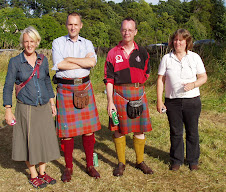I mean to
take life by the throat today – apply for my new driving license; make some
phone calls about the coming-down of the dining room ceiling next Wednesday;
make a list, at least, of other pressing tasks.
I’m
half-way from heel to ribbing.
I feel terribly
sorry for poor
Helen C.K.S. who has let herself finish something without thinking what to
do next. The most bereft of feelings. I mean to go on to socks for Alexander.
My first thought was that he would have to wait, because I only have 100 grams
of his yarn and that means the toes will have to end in something else and I’m
having my toe-up phase at the moment. I can hardly switch yarns on him half-way up the leg.
But, on reflection, there is
really no problem. I can start with the something-else. There are top-down
socks in my husband’s sock drawer, knit in the fashion just mentioned, which
will give me a good idea when it’s safe to switch to the main yarn.
It will be
hard to leave off Zauberball-knitting, even for a little while.
A dreadful
thing: I found moths this week on the madelinetosh yarn which will eventually become my
Effortless or Vitamin D or that twisted-front thingy from VK. I got rid of them
and the yarn is in the freezer, filling an uncomfortable amount of space. It
has been there three days. Is that long enough? I must take it out soon – I
need the space for food – and make sure it’s dry and then put it in a chest
where I think it will be safe.
I mention
this because there was strong evidence that the moths were (like me)
particularly enthusiastic about madelinetosh and ignoring other pure wool yarns
equally accessible nearby. Colour? – the way birds will strip the red current
bush while ignoring the white currents? Or what?
Vegetable-growing
I got
“Fruit and Vegetables for Scotland Scotland
It makes me determined to master some of the easys – notably kale, but also spring onions
and beetroot. My sister and I have been corresponding about her parsley, which
wasn’t doing at all well until moved to another part of the garden. I have no
idea what was wrong – that never hinders an exchange of opinion between
sisters. But my own pontificating has left me convinced that there must be a
reason why the three things just mentioned come up, for me, and then just sit
there, an inch and a half high, for the rest of the summer.
The two
authors write separate parts of the book, rather than collaborating on the
whole. I particularly like this, in the pages on rhubarb: “With a nod in the direction
of Nigel Slater, Caroline recommends baked rhubarb served with crispy fillets
of mackerel. I can’t think of anything worse, myself.”




How about contrast-colour cuffs for the toe-up socks?
ReplyDeleteIn order to be sure my yarn is safe, after making sure there cannot be any wildlife on it, I put the balls or skeins into those supermarket food bags that have a "zip" top - airtight seems a good idea to me!
ReplyDeleteThe mysteries of gardening can be very strange. For several years running I had more beets and chard than I could handle, last year very little matured. So far this year I am having the same problem. I wonder if I need to augment the soil somehow? Or is it just the weather? Quite frustrating. The roses and asparagus have been wonderful, though, so at t,east there's that. Rhubarb and mackerel? The very idea makes me feel queasy.
ReplyDeletethanks for linking to my socks:) and also - I always find that moths have a very good (i.e expensive) taste in yarns:( to be on the safe side (and because I heard that moth eggs can survive deep freezing) I follow an advice given by a museum curator: I first freeze and then heat up my wool in the hot oven for 30 minutes or so (vice versa works the same). as long as there's no polyester in the yarn you'll have no problem. there's no friction to make the yarn felt, it comes out in perfect condition. just make sure that no neighbour of yours wants to finish her chicken in your oven - I got very funny glances by one of mine, when she asked me this just at the moment in time, when I finished my last batch of wool in treatment:) there are probably wild rumours that the poor germans have to eat wool now:)
ReplyDeleteand I'd say rhubarb and mackerel are in the same league as gooseberries and mackerel - never tried it, because it sounds so odd!
My mother always says that moths like the good stuff! MadTosh is a nice soft Merino, and expensive, so that does seem to be true. I have, however, found moth damage to some Gansey yarn remnants that were kicking around in my yarn room, there's nothing less soft than that so I guess if they're desperate they'll go for anything....I imagine the bag the scraps were in sat on the floor and the visitors were more likely carpet beetles than moths and they found an easy meal right there. My other thought is that the yarn might have come in already infested with eggs that have just now hatched. Was it stored in a bag or closed up in any way? I'd be taking a close look for more visitors in any yarn that was close by.
ReplyDeleteI've read that moths can survive being slowly frozen; it's the quick change from room temperature to deep freeze that will kill them. Also, something like 5 seconds per ball in the microwave is reported to kill eggs. I also use the Ziploc-type self-sealing bags for anything suspect or second-hand.
ReplyDeleteI'm rather fond of rhubarb myself but it is very stringy.
In the museum world we have started to use heat as a pest treatment method. This article looks to be well researched:
ReplyDeletehttp://www.pesticide.org/solutions/home-and-garden-toolbox/pest-solutions/clothes-moths
Or you can go to the original literature from museum conservators:
http://cool.conservation-us.org/jaic/articles/jaic21-02-001_2.html
Judith in Ottawa